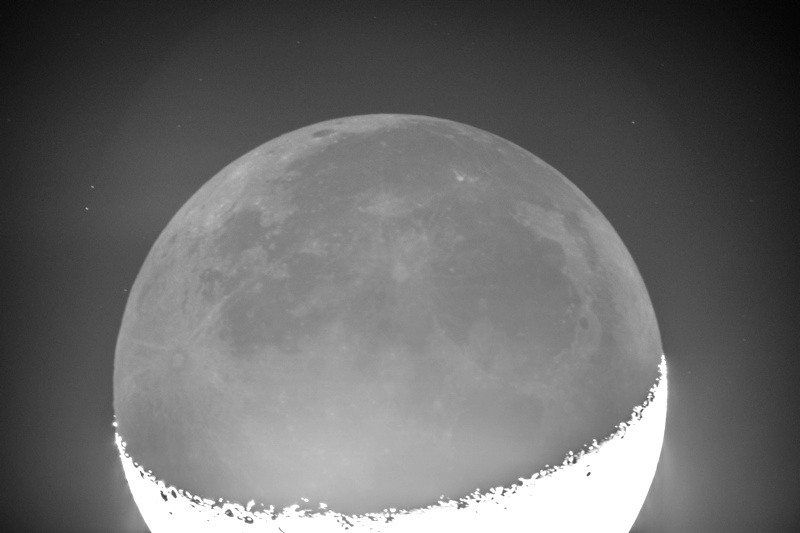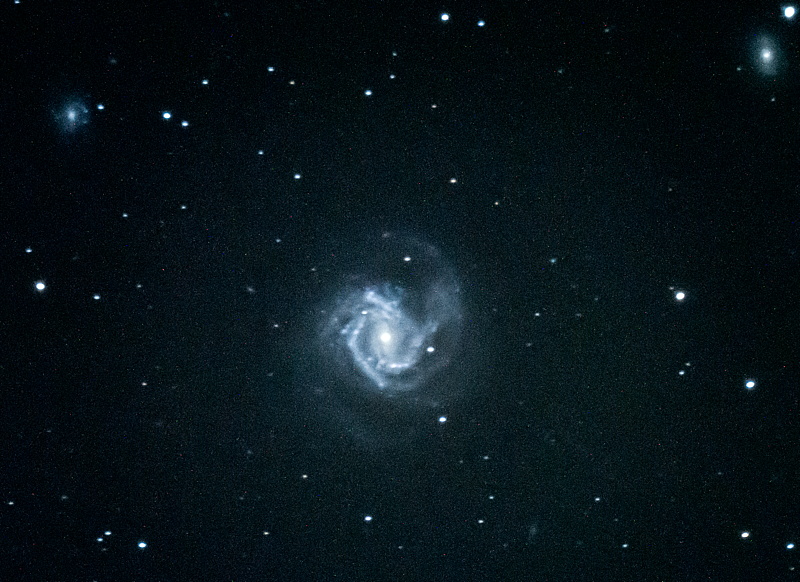Moon, Comet Johnson, Galaxies, Cat's Eye Nebula;
TV Star!
Posted: 1 May 2017
Sunday, 23 April 2017, was cloudy, windy, and had a local power outage. Monday, 24 April, was cloudy and windy (with Red Flag Warnings), both of which continued into Tuesday, 25 April. Clouds and winds decreased on Wednesday, 26 April, but both remained. With a reminder from fellow young Moon observer Rob Sparks I had hoped to try for a 13h45m New Moon after sunset on Wednesday. Unfortunately this is how the sky looked at sunset using the Augmented Reality mode of the iOS app PhotoPills:

Cloudy skies continued on Thursday, 27 April, and Friday, 28 April, with Red Flag wind warnings both days.
Saturday, 29 April, dawned clear and calm, giving hope for a good night. I spent the afternoon and evening at Oracle State Park for their Open House and Star Party. A report is on the Oracle Dark Skies Committee web site.
|
Open: Sunday, 30 April 2017, 1852 MST Temperature: 82°F |
Session: 1105 Conditions: Clear, breezy |
Equipment Used:
12" f/8 LX600 w/StarLock
2" 24mm UWA eyepiece
Camera:
D7200 DSLR
SYNCed the observatory clock to WWV. Then prepared the D7200 DSLR for imaging.
1908 MST: sunset. Calm now.
1911 MST: LX600 ON, StarLock OFF, High Precision OFF.
1913 MST: viewed the Moon, 102X.
1915 MST: Wi-Fi ON. While waiting for the sky to get a little darker I did some tests of the iOS app ScopeBoss. 1930 MST: Wi-Fi OFF. Ended tests.
1950 MST: mounted the D7200 DSLR at prime focus + focal reducer and began imaging the Moon. Here are two photos, both at ISO 400; 1/800sec (top) and 1 second (bottom to show the Earthshine):


2004 MST: ended Moon imaging. Removed the camera. Took a last look at the Moon, 102X. Then viewed Jupiter and the four Galilean Moons, 102X.
2040 MST: Wi-Fi ON. Used SkySafari 5 Pro to GOTO Comet C/2015 V2 (Johnson). There was a nice coma visible with a hint of a short tail. 2049 MST: viewed Comet Johnson using the 12x50 binoculars. It was faintly visible.
2055-2112 MST: short break to get into warmer clothes and to get some hot chocolate for use in the observatory.
2114 MST: began setting up to image the comet. Slewed to the star Arcturus, mounted the DSLR at prime focus + focal reducer, focused on the star, and locked the telescope primary mirror. Returned to Comet C/2015 V2 (Johnson) using SkySafari 5 Pro. 2125 MST: StarLock ON. The comet was visible in the camera viewfinder. This is a StarLock autoguided, 2 minute, ISO 5000, White Balance 3570K, image:

Even with the sky still somewhat bright due to the Moon, the comet's tail is visible.
2143 MST: StarLock OFF, Wi-Fi OFF. Removed the camera and took a final look at the comet, 102X.
2209 MST: viewed Jupiter again, 102X.
2231 MST: dome OFF (onto PZT). Viewed the galaxies M58, M59, M60, and M61, 102X. Then began setting up for imaging. Slewed to the star Spica, mounted the DSLR at prime focus, focused on the star, and locked the primary mirror. 2254 MST: StarLock ON. Took the following images, StarLock autoguided, 5 minutes, ISO 6400, WB 3570K:
M58

M59

M61

M60 and NGC4647

0016 MST: StarLock OFF, dome ON. Slewed to the star Kocab to check focus. Then to NGC6543 (Cat's Eye Nebula, planetary nebula). Had to add the star diagonal in order to be able to look through camera viewfinder to center the nebula. Back to Kocab to focus, locked mirror, then to NGC6543. 0054 MST: StarLock ON. This is a StarLock autoguided, 15 seconds, ISO 800, WB 3570K image of the Cat's Eye Nebula (full-frame with magnified inset):

0108 MST: StarLock OFF. Done imaging. Viewed the Cat's Eye Nebula, 102X. Then viewed Saturn and four of its moons, 102X, but seeing was not very good. Breezes had returned while imaging the galaxies.
Began closing up for the night. As I was doing that the Milky Way was a beautiful sight in the sky with lots of details visible. 0120 MST: LX600 OFF.
|
Close: Monday, 1 May 2017, 0129 MST Temperature: 57°F |
Session Length: 6h 37m Conditions: Clear, breezy |
Adam Block is a southern Arizona astrophotographer who I've had the honor to see at several events over the past two years. The Tucson PBS TV station aired a video story on Adam on its 23 April "Arizona Illustrated" show. Adam appears at 20:56. Check it out.
This recently published article in The Arizona Republic newspaper has some quotes from me: Where are the 'darkest' places in Arizona?.
The Tucson PBS TV station aired a video story about me on Sunday, 30 April. I and Cassiopeia Observatory appear beginning at 10:50. The segment runs about 5 minutes. Check it out!
Comments are welcome using Email. Twitter users can use the button below to tweet this report to your followers. Thanks.
Cassiopeia Observatory Home Page
Copyright ©2017 Michael L. Weasner / mweasner@me.com
URL = http://www.weasner.com/co/Reports/2017/05/01/index.html

